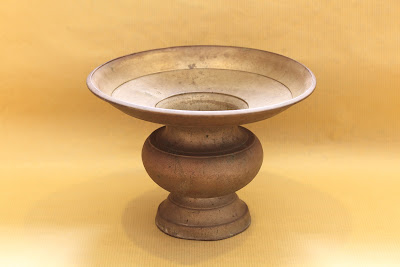Commonly, spittoon is known as a receptacle made for spitting into, especially by users of chewing and dipping tobacco. Brass was the most common material for spittoons. Other materials used for mass production of spittoons ranged from basic functional iron to elaborately crafted cut glass and fine porcelain.
Spittoons are flat-bottomed, often weighted to minimize tipping over, and often with an interior "lip" to make spilling less likely if they tip. Some have lids, but most not.
Use of spittoons was considered an advance of public manners and health, intended to replace previously common spitting on floors, streets, and sidewalks.
In China, during the Qing Dynasty, a golden spittoon would be among the numerous objects displayed in front of the Emperor at major ceremonies. After China became a Communist state in 1949, the spittoon became much more prevalent. The spittoons used in China were typically made of white porcelain, sometimes with traditional Chinese art painted onto the exterior. Spittoons were placed at every conceivable public place, and were commonplace in homes as well. The mass introduction of spittoons was no doubt a public hygiene initiative, motivated by a desire to correct the once common Chinese practice of spitting onto the floor.
Pictures below are the spittoons from my collection.
 Picture 2
Picture 2
These brass spittoons (pictures 1 and 2) are relatively unadorned with decoration, which is typical of the more restrained style of peninsular Malay brass work. Spittoons such as these example were used by Malays and Straits Chinese for betel consumption, and by newly arrived Chinese as part of their opium paraphernalia.
For the Peranakans, spittoons in all shapes and sizes were used. There were small ones for the table (picture 6), to be used during chewing of sirih or betel leaves. But these three different spittoons (pictures 3, 4 and 5) would be placed in the living room or under the table for daily use.
 Picture 6
Picture 6
Spittoon which normally can be seen in the Straits Chinese family.
It is small in size and to be used by the Nyonyas or Bibiks chewing sirih or betel leaves. It is small enough to sit on the palm of your hands. It is with floral motifs and would normally be placed on the table, together with the tepak sirih.
Picture below is another type of spittoon which is still being used today, especially during the Chinese wedding ceremony. The spittoon is in red colour with the double happiness characters. It will normally be placed in the newly married couple's room especially under the dressing table or at the edge of the bed.
Also check out the "Silver Betel / Tobacco Box", the "Betel Nut Paraphernalia", the "Asam Gelugor Fruit-Shaped Brass Container", the "Indonesian Betel Or Tobacco Box" and the "Porcelain Spittoon".
Spittoons are flat-bottomed, often weighted to minimize tipping over, and often with an interior "lip" to make spilling less likely if they tip. Some have lids, but most not.
Use of spittoons was considered an advance of public manners and health, intended to replace previously common spitting on floors, streets, and sidewalks.
In China, during the Qing Dynasty, a golden spittoon would be among the numerous objects displayed in front of the Emperor at major ceremonies. After China became a Communist state in 1949, the spittoon became much more prevalent. The spittoons used in China were typically made of white porcelain, sometimes with traditional Chinese art painted onto the exterior. Spittoons were placed at every conceivable public place, and were commonplace in homes as well. The mass introduction of spittoons was no doubt a public hygiene initiative, motivated by a desire to correct the once common Chinese practice of spitting onto the floor.
Pictures below are the spittoons from my collection.
These brass spittoons (pictures 1 and 2) are relatively unadorned with decoration, which is typical of the more restrained style of peninsular Malay brass work. Spittoons such as these example were used by Malays and Straits Chinese for betel consumption, and by newly arrived Chinese as part of their opium paraphernalia.
For the Peranakans, spittoons in all shapes and sizes were used. There were small ones for the table (picture 6), to be used during chewing of sirih or betel leaves. But these three different spittoons (pictures 3, 4 and 5) would be placed in the living room or under the table for daily use.
 Picture 6
Picture 6Spittoon which normally can be seen in the Straits Chinese family.
It is small in size and to be used by the Nyonyas or Bibiks chewing sirih or betel leaves. It is small enough to sit on the palm of your hands. It is with floral motifs and would normally be placed on the table, together with the tepak sirih.
Picture below is another type of spittoon which is still being used today, especially during the Chinese wedding ceremony. The spittoon is in red colour with the double happiness characters. It will normally be placed in the newly married couple's room especially under the dressing table or at the edge of the bed.
Also check out the "Silver Betel / Tobacco Box", the "Betel Nut Paraphernalia", the "Asam Gelugor Fruit-Shaped Brass Container", the "Indonesian Betel Or Tobacco Box" and the "Porcelain Spittoon".






No comments:
Post a Comment